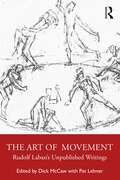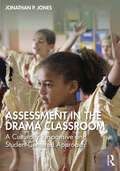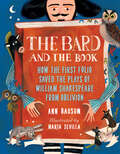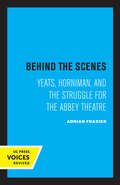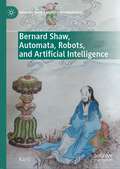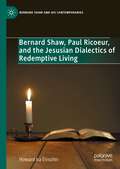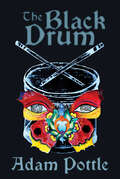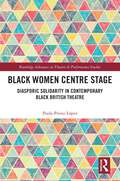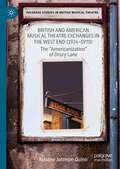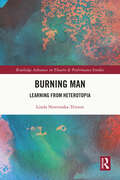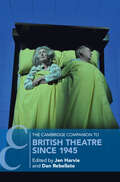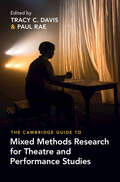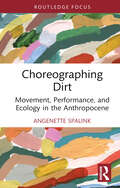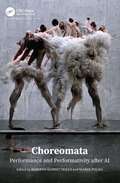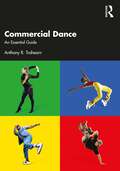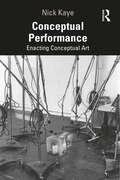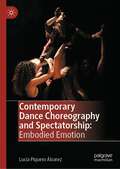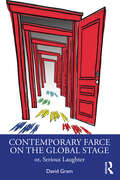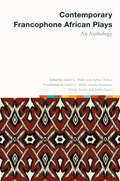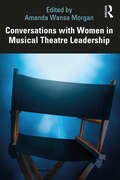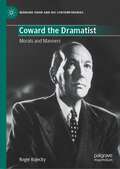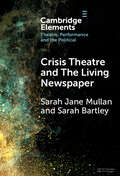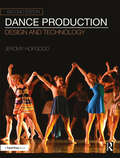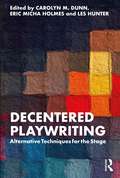- Table View
- List View
The Art of Movement: Rudolf Laban’s Unpublished Writings
by Dick McCawThe Art of Movement: Rudolf Laban’s Unpublished Writings offers new perspectives on the thinking and practice of Rudolf Laban – one of the pioneers of modern European dance and movement analysis. A wealth of Laban’s previously untranslated writings broadens our understanding of his work through new perspectives on his thinking and practice. Alongside these key primary sources, interviews with Laban’s family and colleagues and editorial commentaries shed new light on the significance of his life and career. Laban’s own texts also offer further elaboration of the key themes of his work – eukinetics, choreutics, lay dance, pedagogy and dance notation. This essential companion to The Laban Sourcebook is an ideal resource for any students or scholars of modern dance, dance studies, dance history and movement analysis looking for a deeper understanding of this seminal figure in their field.
Assessment in the Drama Classroom: A Culturally Responsive and Student-Centered Approach
by Jonathan P. JonesThis textbook offers a practical approach for designing and implementing assessment for learning in the drama classroom. Assessment in the Drama Classroom begins with a theoretical overview that covers the purpose of assessment with student-centered, culturally responsive methods. The following chapters present an in-depth analysis of how to organize drama curriculum, develop measurable learning objectives, and implement a backward planning approach to summative assessment. Models and tools for generating diagnostic, formative, and summative assessments for various grade levels invite the reader to adapt these approaches to their classrooms. Ideal for drama education and pedagogy courses, this book is an accessible tool for drama educators to engage in critical reflection on assessment. Drama educators will find methods and suggestions for reimagining their assessment practices and be empowered to meet the learning needs of their students.
Assessment in the Drama Classroom: A Culturally Responsive and Student-Centered Approach
by Jonathan P. JonesThis textbook offers a practical approach for designing and implementing assessment for learning in the drama classroom.Assessment in the Drama Classroom begins with a theoretical overview that covers the purpose of assessment with student-centered, culturally responsive methods. The following chapters present an in-depth analysis of how to organize drama curriculum, develop measurable learning objectives, and implement a backward planning approach to summative assessment. Models and tools for generating diagnostic, formative, and summative assessments for various grade levels invite the reader to adapt these approaches to their classrooms.Ideal for drama education and pedagogy courses, this book is an accessible tool for drama educators to engage in critical reflection on assessment. Drama educators will find methods and suggestions for reimagining their assessment practices and be empowered to meet the learning needs of their students.
The Bard and the Book: How the First Folio Saved the Plays of William Shakespeare from Oblivion
by Ann BausumThe unlikely true story of why we know the name William Shakespeare today, and the four-hundred-year-old book that made it possible.Four hundred years ago, no one bothered to write down the exact words of stage plays. Characters&’ lines were scribbled on small rolls of paper (as in, an actor&’s role) and passed around, but no master script was saved for the future. The main reason we&’ve heard of Romeo, Juliet, Hamlet, and Shakespeare himself is that a group of people made the excellent choice to preserve the plays after the Bard died. If they hadn&’t created the book known as the First Folio, Shakespeare and his works would surely have been lost to history. Part literary scavenger hunt (the search for every existing First Folio continues today), part book trivia treasure trove, and part love letter to Shakespeare, this behind-the-scenes, sharply funny true story is an ideal introduction to the Bard and his famous plays.
Behind the Scenes: Yeats, Horniman, and the Struggle for the Abbey Theatre (The New Historicism: Studies in Cultural Poetics #11)
by Adrian FrazierBehind the Scenes presents the story of Dublin's famous Abbey Theatre and its major creative personalities: W. B. Yeats, Annie Horniman, J. M. Synge, and Lady Gregory. Part history, part sociology, part biography, Frazier's work recreates the forces that shaped the Abbey stage, forces that involved the spirited participation of actors, audiences, press, and financiers as well as of the famous poet-playwright who was its co-director. His book unfolds an entertaining and suspenseful tale, centered on the undeniably autocratic personality of W.B. Yeats and with the political struggles of Ireland as a backdrop. This title is part of UC Press's Voices Revived program, which commemorates University of California Press's mission to seek out and cultivate the brightest minds and give them voice, reach, and impact. Drawing on a backlist dating to 1893, Voices Revived makes high-quality, peer-reviewed scholarship accessible once again using print-on-demand technology. This title was originally published in 1990.
Bernard Shaw, Automata, Robots, and Artificial Intelligence (Bernard Shaw and His Contemporaries)
by Kay LiThis project is the first to explore how Bernard Shaw intersects constructively with automata, robots and artificial intelligence (AI). Shaw was born in the golden age of the automaton. His Bible on the Life Force and Creative Evolution, Back to Methuselah, was written when Karel and Josef Čapek coined the word “robot.” Shaw’s life ran in parallel with the rise of AI, and the big names in AI were his contemporaries. Moreover, empirical analyses of Shavian texts and images using AI uncovers possibilities for new interpretations, demonstrating how future renditions of his works may make use of these advanced technologies to broaden Shaw’s audience, readership and scholarship.
Bernard Shaw, Paul Ricoeur, and the Jesusian Dialectics of Redemptive Living (Bernard Shaw and His Contemporaries)
by Howard Ira EinsohnThis book explores a heretofore unremarked linkage between Bernard Shaw, the twentieth-century French thinker Paul Ricoeur, and Jesus of Nazareth. The ties that bind them are a foundational interest in the social teachings of the Nazarene and their use of a shared dialectics with respect to living the kind of compassionate life that holds out the promise in our contemporary world of achieving something approximating universal wellness on a healthy planet at peace with itself. This work argues that the three principal subjects of the study—independently of one another—used the same dialectical method to reach the same dialectically derived conclusion about how humans can live redemptively in a fractured world.
The Black Drum
by Adam PottleHailed as the world’s first Deaf musical—told entirely in American Sign Language and Signed Music—The Black Drum revolves around Joan and her journey to healing after the death of her wife, Karen. Since Karen’s passing, Joan has been unable to share her music with the world, anguish snatching her desire to perform. Joan’s grief pulls her into a bizarre, black-and-white world where her two beautiful tattoos come to life as guides and together they confront a monster called the Minister. But the only way to defeat the Minister and begin to heal is for Joan to embrace her own voice.An epic fantasy about grief and healing, The Black Drum questions the concept of music we are conditioned to believe, suggesting that music is not just something you hear, it is something you see and feel.
Black Women Centre Stage: Diasporic Solidarity in Contemporary Black British Theatre (Routledge Advances in Theatre & Performance Studies)
by Paola Prieto LópezThis book examines the political alliances that are built across the diaspora in contemporary plays written by Black women playwrights in the UK. Through the concept of creative diasporic solidarity, it offers an innovative theoretical approach to examine the ways in which the playwrights respond creatively to the violence and marginalisation of Black communities, especially Black women. This study demonstrates that theatre can act as a productive space for the ethical encounter with the Other (understood in terms of alterity, as someone different from the self) by examining the possibilities of these plays to activate the spectators’ responsibility and solidarity towards different types of violence experienced by Black women, offering alternative modes of relationality. The book engages with a range of contemporary works written by Black women playwrights in the UK, including Mojisola Adebayo, Theresa Ikoko, Diana Nneka Atuona, Gloria Williams, Charlene James, or Yusra Warsama, bringing to the fore a gendered and intersectional approach to the analysis of the texts. This book will be of great interest to students and scholars in contemporary theatre, gender studies and diaspora studies.
British and American Musical Theatre Exchanges in the West End: The “Americanization” of Drury Lane (Palgrave Studies in British Musical Theatre)
by Arianne Johnson QuinnThis monograph centres on the history of musical theatre in a space of cultural significance for British identity, namely the Theatre Royal, Drury Lane, which housed many prominent American productions from 1924-1970. It argues that during this period Drury Lane was the site of cultural exchanges between Britain and the United States that were a direct result of global engagement in two world wars and the evolution of both countries as imperial powers. The critical and public response to works of musical theatre during this period, particularly the American musical, demonstrates the shifting response by the public to global conflict, the rise of an American Empire in the eyes of the British government, and the ongoing cultural debates about the role of Americans in British public life. By considering the status of Drury Lane as a key site of cultural and political exchanges between the United States and Britain, this study allows us to gain a more complete portrait of the musical’s cultural significance in Britain.
Burning Man: Learning from Heterotopia (Routledge Advances in Theatre & Performance Studies)
by Linda Noveroske-TrittenThis book centres on a philosophical analysis of creative acts in the Burning Man Festival and their roles in wider social change. With particular focus on the Ten Principles of Burning Man, Linda Noveroske posits a re-interpretation of common notions of “self” and “other” as they apply to identity, difference, and the ways that these personal impulses ripple outward from changing individuals into changing societies. Such radical re-imagination of ideology can be most powerful when it occurs in spaces of otherness, of heterotopia. This study casts Burning Man as a heterotopia to not only destabilizes what we think we know about visual art, performance, and creative encounters, but also bring these acts into an attitude of immediacy that facilitates previously unimagined behaviour and opens out artistic drive into the unknown. This book would be of value for scholars and practitioners in Performance Studies, Theatre and Dance, Art History, Psychology, Phenomenology, Architecture and Urban Studies.
The Cambridge Companion to British Theatre since 1945 (Cambridge Companions to Theatre and Performance)
by Jen Harvie Dan RebellatoBritish theatre underwent a vast transformation and expansion in the decades after World War II. This Companion explores the historical, political, and social contexts and conditions that not only allowed it to expand but, crucially, shaped it. Resisting a critical tendency to focus on plays alone, the collection expands understanding of British theatre by illuminating contexts such as funding, unionisation, devolution, immigration, and changes to legislation. Divided into four parts, it guides readers through changing attitudes to theatre-making (acting, directing, writing), theatre sectors (West End, subsidised, Fringe), theatre communities (audiences, Black theatre, queer theatre), and theatre's relationship to the state (government, infrastructure, nationhood). Supplemented by a valuable Chronology and Guide to Further Reading, it presents up-to-date approaches informed by critical race theory, queer studies, audience studies, and archival research to demonstrate important new ways of conceptualising post-war British theatre's history, practices and potential futures.
The Cambridge Guide to Mixed Methods Research for Theatre and Performance Studies
by Tracy C. Davis Paul RaeWe often know performance when we see it – but how should we investigate it? And how should we interpret what we find out? This book demonstrates why and how mixed methods research is necessary for investigating and explaining performance and advancing new critical agendas in cultural study. The wide range of aesthetic forms, cultural meanings, and social functions found in theatre and performance globally invites a corresponding variety of research approaches. The essays in this volume model reflective consideration of the means, processes, and choices for conducting performance research that is historical, ethnographic, aesthetic, or computational. An international set of contributors address what is meant by planning or designing a research project, doing research (locating and collecting primary sources or resources), and the ensuing work of interpreting and communicating insights. Providing illuminating and necessary guidance, this volume is an essential resource for scholars and students of theatre, performance, and dance.
Choreographing Dirt: Movement, Performance, and Ecology in the Anthropocene (Routledge Studies in Theatre, Ecology, and Performance)
by Angenette SpalinkThis book is an innovative study that places performance and dance studies in conversation with ecology by exploring the significance of dirt in performance. Focusing on a range of 20th- and 21st-century performances that include modern dance, dance-theatre, Butoh, and everyday life, this book demonstrates how the choreography of dirt makes biological, geographical, and cultural meaning, what the author terms "biogeocultography". Whether it’s the Foundling Father digging into the earth’s strata in Suzan-Lori Park’s The America Play (1994), peat hurling through the air in Pina Bausch’s The Rite of Spring (1975), dancers frantically shovelling out fistfuls of dirt in Eveoke Dance Theatre’s Las Mariposas (2010), or Butoh performers dancing with fungi in Iván-Daniel Espinosa’s Messengers Divinos (2018), each example shows how the incorporation of dirt can reveal micro-level interactions between species – like the interplay between microscopic skin bacteria and soil protozoa – and macro-level interactions – like the transformation of peat to a greenhouse gas. By demonstrating the stakes of moving dirt, this book posits that performance can operate as a space to grapple with the multifaceted ecological dilemmas of the Anthropocene. This book will be of broad interest to both practitioners and researchers in theatre, performance studies, dance, ecocriticism, and the environmental humanities.
Choreomata: Performance and Performativity after AI
by Roberto Alonso TrilloIs artificial intelligence (AI) becoming more and more expressive, or is human thought adopting more and more structures from computation? What does it mean to perform oneself through AI, or to construct one’s subjectivity through AI? How does AI continue to complicate what it means to have a body? Has the golden age of AI, especially with regards to creative applications, already ended? Choreomata: Performance and Performativity after AI is a book about performance and performativity, but more specifically, it is a book about the performance of artificiality and the performance of intelligence. Both humans and human-designed computational forces are thoroughly engaged in an entangled, mutual performance of AI. Choreomata spins up a latticework of interdisciplinary thought, pairing theoretical inquiry from philosophy, information theory, and computer science with practical case studies from visual art, dance, music, and social theory. Through cross-disciplinary proportions and a diverse roster of contributors, this book contains insights for computer scientists, social scientists, industry professionals, artists, and beyond.
Commercial Dance: An Essential Guide
by Anthony R. TrahearnThis is an exploration of the vital and rapidly evolving world of Commercial Dance, tracing the evolution and merging of Hip-Hop, Club and Jazz dance styles from the music videos of the early 1980s, to today's huge influence on pop music and dance in a multi-media culture. Chapters including ‘Iconic Moments’ and ‘Main Movers’ contextualise and analyse culturally significant works and choreographers. With direct contributions from an international array of industry leading dancers, choreographers and creatives - including JaQuel Knight (Beyonce’s choreographer), Rich + Tone Talauega (Madonna & Michael Jackson collaborators), Rebbi Rosie (Rihanna’s dancer), Dean Lee (Janet Jackson’s choreographer) and Kiel Tutin (BLACKPINK’s choreographer) - this book shines a light on the creatives in the Commercial Dance industry who have made significant impacts, not just on the world of dance but on popular culture itself. Chapters discussing dance history, copyright law, inclusivity and dance class culture as well as additional contributions from dance scholars enable this book to give credence to Commercial Dance as a legitimate academic area of study. This is a complete and comprehensive textbook for all dance students at any level of study on college, university or conservatory courses.
Conceptual Performance: Enacting Conceptual Art
by Nick KayeConceptual Performance explores how the radical visual art that challenged material aesthetics in the 1960s and 1970s tested and extended the limits, character and concept of performance. Conceptual Performance sets out the history, theoretical basis, and character of this genre of work through a wide range of case studies. The volume considers how and why principal modes and agendas in Conceptual art in the 1960s and 1970s necessitated new engagements with performance, as well as expanded notions of theatricality. In doing so, this book reviews and challenges prevailing histories of Conceptual art through critical frameworks of performativity and performance. It also considers how Conceptual art adopted and redefined terms and tropes of theatre and performance: including score, document, embodiment, documentation, relic, remains, and the narrative recuperation of ephemeral work. While showing how performance has been integral to Conceptual art’s critiques of prevailing assumptions about art’s form, purpose, and meaning, this volume also considers the reach and influence of Conceptual performance into recent thinking and practice. This book will be of interest to scholars and students of theatre, performance, contemporary art, and art history.
Contemporary Dance Choreography and Spectatorship: Embodied Emotion
by Lucía Piquero ÁlvarezThis book offers an approach which unites choreographic and spectatorial perspectives, and argues for dance itself—its materials, its structures—as a medium of emotional communication. Contemporary dance often seems to contend with issues of understanding, regularly being “read” in “languages” which alienate it. Even if emotion seems a significant part of people’s engagement with dance, its workings are often surrounded by an air of mysticism. Engaging with these issues, this study investigates the experience of emotion in Euro-American contemporary dance theatre. It questions its dependence on the artist’s personal emotions, and the assumption that it is mediated by representational meaning. Instead, this book proposes that the emotional import of dance emerges from an interplay between perceptual properties and symbolic elements in an embodied affective cognitive experience. This experience includes the background of the spectator as well as the context of work, choreographer, performer(s) and other creative agents.
Contemporary Farce on the Global Stage: or, Serious Laughter
by David GramContemporary Farce on the Global Stage provides audiences and practitioners a detailed survey of how the genre of farce has evolved in the 21st century. Often dismissed as frivolous, farce speaks a universal language, with the power to incisively interrogate our world through laughter.Unlike farces of the past, where a successful resolution was a given and we could laugh uproariously at adulterous behaviour, farce no longer guarantees an audience a happy ending where everything works out. Contemporary farce is no longer ‘diverting us’ with laughter. It is reflecting the fractured world around us. With a foreword by award-winning playwright Ken Ludwig, the book introduces readers to the Mechanics of Farce, and the ‘Four Ps,’ which are key elements for understanding, appreciating, and exploring the form. The Five Doors to Contemporary Farce identify five major categories into which farces fall. Behind each door are a wide selection of plays, modern and contemporary examples from all over the world, written by a diverse group of playwrights who traverse gender, race, ethnicity, and sexual orientation. Supplementing each section are comments, observations, and reflections from award-winning playwrights, directors, actors, designers, dramaturgs, and scholars.Designed specifically to give theatre-makers a rounded understanding that will underpin their own productions, this book will also be of use to theatre and performance studies students.
Contemporary Francophone African Plays: An Anthology (Scènes francophones: Studies in French and Francophone Theater)
by Edited by Judith G. MillerBringing together in English translation eleven Francophone African plays dating from 1970 to 2021, this essential collection includes satirical portraits of colonizers and their collaborators (Bernard Dadié’s Béatrice du Congo; Sony Labou Tansi’s I, Undersigned, Cardiac Case; Sénouvo Agbota Zinsou’s We’re Just Playing) alongside contemporary works questioning diasporic identity and cultural connections (Koffi Kwahulé’s SAMO: A Tribute to Basquiat and Penda Diouf’s Tracks, Trails, and Traces…). The anthology memorializes the Rwandan genocide (Yolande Mukagasana’s testimony from Rwanda 94), questions the status of women in entrenched patriarchy (Werewere Liking’s Singuè Mura: Given That a Woman…), and follows the life of Elizabeth Nietzsche, who perverted her brother’s thought to colonize Paraguay (José Pliya’s The Sister of Zarathustra). Gustave Akakpo’s The True Story of Little Red Riding Hood and Kossi Efoui’s The Conference of the Dogs offer parables about what makes life livable, while Kangni Alem’s The Landing shows the dangers of believing in a better life, through migration, outside of Africa.
Conversations with Women in Musical Theatre Leadership
by Amanda Wansa MorganMost writers, composers, librettists, and music directors who make their careers in musical theatre do so without specific training or clear pathways to progress through the industry. Conversations with Women in Musical Theatre Leadership addresses that absence by drawing on the experiences of these women to show the many and varied routes to successful careers on, off, and beyond Broadway. Conversations with Women in Musical Theatre Leadership features 15 interviews with Broadway-level musical theatre music directors, directors, writers, composers, lyricists, stage managers, orchestrators, music arrangers, and other women in positions of leadership. Built around extensive interviews with women at the top of their careers in the creative and leadership spheres of musical theatre, these first-hand accounts offer insight into the jobs themselves, the skills that they require, and how those skills can be developed. Any students of musical theatre and stagecraft, no matter what level and in what setting from professional training to university and conservatory study, will find this a valuable asset.
Coward the Dramatist: Morals and Manners (Bernard Shaw and His Contemporaries)
by Roger KojeckyDiscussions of Coward’s achievement in the theatre between 1920 and 1966 have tended to stay with the colourful biography. The more analytical literary approach adopted here places Coward’s success in its wider theatrical context, making the connections with the work of other dramatists. He developed his technique according to what worked with theatre audiences. Taking up the well-made play, he brought in a more colloquial dialogue, explored, for instance, the morality and psychology of marriage and free love, and frequently exploited the dramatic possibilities of characters grouped into two camps. The book considers both the ‘pleasant’ and ‘unpleasant’ plays (to use the Shavian terms), and the episodic patriotic plays. It Includes Coward’s ambivalent approach to the ‘theatre of war’ in the 20th century. (123)
Crisis Theatre and The Living Newspaper (Elements in Theatre, Performance and the Political)
by null Sarah Jane Mullan null Sarah BartleyCrisis Theatre and The Living Newspapers traces a history of the living newspaper as a theatre of crisis from Soviet Russia (1910s), through the Federal Theatre Project of the Great Depression in America (1930s), to Augusto Boal's teatro jornal in Brazil (1970s), and its resonance with documentary forms deployed in the final years of apartheid in South Africa (1990s), up until the present day in the UK (2020s). Across this Element, the author is interested in what a transnational and transhistorical examination of the living newspaper through the lens of crisis reveals about the ways in which theatre can intervene in our collective social, economic and political life. By holding these diverse examples together, the author asserts the Living Newspaper as a form of Crisis Theatre.
Dance Production: Design and Technology
by Jeromy HopgoodDance Production: Design and Technology, Second Edition is an introduction to the skills needed to plan, design, and execute the technical aspects of a dance production.Covering a broad range of topics, author Jeromy Hopgood takes the reader through the process of producing dance from start to finish. Part I addresses the collaborative process, business and organizational concerns for dance companies, planning the production, and the relationship between dance and performance spaces/staging methods. In Part II, each unique production area is examined, including production and stage management, sound, costume and makeup, scenery and props, lighting, and projection/video design. Each design area is divided into two chapters – the first introducing key concepts, and the second focusing on the process of creating the design. Part III brings back the popular quick reference guides from the first edition, providing an expanded and revised tool to bridge the language gap between the worlds of theatrical production and dance, and ensure productive communication across the different fields. This second edition features updated information on technology and processes, two new chapters on touring and non-traditional productions, more information on arts management within dance production, a comprehensive look at dance and video (including remote/streaming performances, as well as dance film), and additional chapter projects throughout the book.This unique book approaches the process of staging a dance production from a balanced perspective, making it an essential resource for choreographers, theatre designers, dancers, and management personnel alike, including for use in Dance and Dance Production courses.
Decentered Playwriting: Alternative Techniques for the Stage
by Carolyn M. DunnDecentered Playwriting investigates new and alternative strategies for dramatic writing that incorporate non-Western, Indigenous, and underrepresented storytelling techniques and traditions while deepening a creative practice that decenters hegemonic methods. A collection of short essays and exercises by leading teaching artists, playwrights, and academics in the fields of playwriting and dramaturgy, this book focuses on reimagining pedagogical techniques by introducing playwrights to new storytelling methods, traditions, and ways of studying, and teaching diverse narratological practices. This is a vital and invaluable book for anyone teaching or studying playwriting, dramatic structure, storytelling at advanced undergraduate and graduate levels, or as part of their own professional practice.
